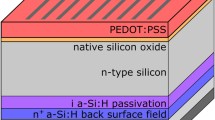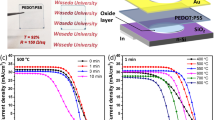Abstract
Germanium monoselenide (GeSe) is an emerging promising photovoltaic absorber material due to its attractive optoelectronic properties as well as non-toxic and earth-abundant constitutes. However, all previously reported GeSe solar cells rely on a superstrate configuration coupled with a CdS buffer layer, and suffer from unsatisfactory performance. Here we demonstrate that this low efficiency arises from the inevitable high-temperature treatment of p-n junction in superstrate configuration. This results in the diffusion of Cd atoms from CdS layer into GeSe film that introduces detrimental deep trap states inside the bandgap of GeSe (∼0.34 eV below conduction band minimum). We adopt therefore a substrate configuration that enables the deposition of CdS atop pre-deposited polycrystalline GeSe film at room temperature, avoiding the Cd diffusion. By optimizing the annealing temperature of complete devices via a high-throughput screening method, the resulting substrate solar cells annealed at 150°C achieve an efficiency of 3.1%, two times that of the best previously reported superstrate GeSe results.

摘要
GeSe作为一种新兴光伏吸收层材料, 具有良好的光电性能, 且原料无毒、 储量丰富. 然而, 以往报道的GeSe太阳能电池都采用顶衬结构, 并使用CdS缓冲层, 性能不理想. 本文发现顶衬结构GeSe太阳能电池效率低下的原因是不可避免的p-n结高温热处理. 这导致Cd原子从CdS层扩散到GeSe薄膜中, 并在GeSe的禁带内引入有害的深缺陷态(位于导带底~0.34 eV的位置). 因此, 我们首次制备了底衬结构GeSe太阳能电池. 该结构可实现CdS层在多晶GeSe薄膜上的室温沉积, 从而避免了有害的Cd扩散. 通过进一步采用高通量的筛选方法来优化器件的退火温度, 当退火温度在150°C时, 器件效率达到最高的3.1%, 为以前报道最佳结果的2倍.
Similar content being viewed by others
References
Xue DJ, Liu SC, Dai CM, et al. GeSe thin-film solar cells fabricated by self-regulated rapid thermal sublimation. J Am Chem Soc, 2017, 139: 958–965
Wang X, Li Y, Huang L, et al. Short-wave near-infrared linear dichroism of two-dimensional germanium selenide. J Am Chem Soc, 2017, 139: 14976–14982
Zhou X, Hu X, ** B, et al. Highly anisotropic GeSe nanosheets for phototransistors with ultrahigh photoresponsivity. Adv Sci, 2018, 5: 1800478
Zhou X, Zhang Q, Gan L, et al. Booming development of group IV-VI semiconductors: Fresh blood of 2D family. Adv Sci, 2016, 3: 1600177
Solanki GK, Deshpande MP, Agarwal MK, et al. Thermoelectric power factor measurements in GeSe single crystals grown using different transporting agents. J Mater Sci Lett, 2003, 22: 985–987
Yang Y, Liu SC, Wang Y, et al. In-plane optical anisotropy of low-symmetry 2D GeSe. Adv Opt Mater, 2019, 7: 1801311
Liu SC, Mi Y, Xue DJ, et al. Investigation of physical and electronic properties of GeSe for photovoltaic applications. Adv Electron Mater, 2017, 3: 1700141
Liu SC, Yang Y, Li Z, et al. GeSe thin-film solar cells. Mater Chem Front, 2020, 4: 775–787
Huang Z, Miller SA, Ge B, et al. High thermoelectric performance of new rhombohedral phase of GeSe stabilized through alloying with AgSbSe2. Angew Chem Int Ed, 2017, 56: 14113–14118
von Rohr FO, Ji H, Cevallos FA, et al. High-pressure synthesis and characterization of β-GeSe—a six-membered-ring semiconductor in an uncommon boat conformation. J Am Chem Soc, 2017, 139: 2771–2777
Sarkar D, Ghosh T, Roychowdhury S, et al. Ferroelectric instability induced ultralow thermal conductivity and high thermoelectric performance in rhombohedral p-type GeSe crystal. J Am Chem Soc, 2020, 142: 12237–12244
Zhao H, Mao Y, Mao X, et al. Band structure and photoelectric characterization of GeSe monolayers. Adv Funct Mater, 2018, 28: 1704855
Ye Y, Guo Q, Liu X, et al. Two-dimensional GeSe as an isostructural and isoelectronic analogue of phosphorene: Sonication-assisted synthesis, chemical stability, and optical properties. Chem Mater, 2017, 29: 8361–8368
Yap WC, Yang Z, Mehboudi M, et al. Layered material GeSe and vertical GeSe/MoS2 p-n heterojunctions. Nano Res, 2018, 11: 420–430
Yang Z, Liao L, Gong F, et al. WSe2/GeSe heterojunction photodiode with giant gate tunability. Nano Energy, 2018, 49: 103–108
Kirchartz T, Rau U. What makes a good solar cell? Adv Energy Mater, 2018, 8: 1703385
Vaughn II DD, Schaak RE. Synthesis, properties and applications of colloidal germanium and germanium-based nanomaterials. Chem Soc Rev, 2013, 42: 2861–2879
Lu Z, Neupane GP, Jia G, et al. 2D materials based on main group element compounds: Phases, synthesis, characterization, and applications. Adv Funct Mater, 2020, 30: 2001127
Chen B, Chen G, Wang W, et al. Magnetron sputtering deposition of GeSe thin films for solar cells. Sol Energy, 2018, 176: 98–103
Zi W, Mu F, Lu X, et al. Post-annealing treatment of a-GeSe thin films for photovoltaic application. Sol Energy, 2020, 199: 837–843
Zhou Y, Wang L, Chen S, et al. Thin-film Sb2Se3 photovoltaics with oriented one-dimensional ribbons and benign grain boundaries. Nat Photon, 2015, 9: 409–415
Tang R, Wang X, Lian W, et al. Hydrothermal deposition of antimony selenosulfide thin films enables solar cells with 10% efficiency. Nat Energy, 2020, 5: 587–595
Lv X, Wei W, Mu C, et al. Two-dimensional GeSe for high performance thin-film solar cells. J Mater Chem A, 2018, 6: 5032–5039
Cheng K, Guo Y, Han N, et al. Lateral heterostructures of monolayer group-IV monochalcogenides: Band alignment and electronic properties. J Mater Chem C, 2017, 5: 3788–3795
Hou GJ, Wang DL, Ali R, et al. CH3NH3PbI3/GeSe bilayer heterojunction solar cell with high performance. Sol Energy, 2018, 159: 142–148
Bob B, Lei B, Chung CH, et al. The development of hydrazine-processed Cu(In,Ga)(Se,S)2 solar cells. Adv Energy Mater, 2012, 2: 504–522
Chirilă A, Buecheler S, Pianezzi F, et al. Highly efficient Cu(In,Ga)-Se2 solar cells grown on flexible polymer films. Nat Mater, 2011, 10: 857–861
Shin D, Saparov B, Mitzi DB. Defect engineering in multinary earth-abundant chalcogenide photovoltaic materials. Adv Energy Mater, 2017, 7: 1602366
Li Z, Liang X, Li G, et al. 9.2%-efficient core-shell structured antimony selenide nanorod array solar cells. Nat Commun, 2019, 10: 125
Liu SC, Yang Y, Zhang X, et al. Tuning the optical absorption property of GeSe thin films by annealing treatment. Phys Status Solidi RRL, 2018, 12: 1800370
Zhou Y, Li Y, Luo J, et al. Buried homojunction in CdS/Sb2Se3 thin film photovoltaics generated by interfacial diffusion. Appl Phys Lett, 2017, 111: 013901
Ohta K, Sugiyama T, Mizuno T. Atom formation processes for cadmium in the presence of sulphur in electrothermal atomization atomic absorption spectrometry with a molybdenum tube atomizer. Anal Chim Acta, 1990, 236: 479–482
Liu SC, Li Z, Yang Y, et al. Investigation of oxygen passivation for high-performance all-inorganic perovskite solar cells. J Am Chem Soc, 2019, 141: 18075–18082
Wang L, Luo M, Qin S, et al. Ambient CdCl2 treatment on CdS buffer layer for improved performance of Sb2Se3 thin film photovoltaics. Appl Phys Lett, 2015, 107: 143902
Acknowledgements
This work was supported by the National Natural Science Foundation of China (21911512 and 21875264), and the Youth Innovation Promotion Association CAS (2017050). The authors thank Dr. **ang Li (ICCAS) for the preparation of TEM samples.
Author information
Authors and Affiliations
Contributions
Author contributions Xue DJ and Liu SC conceived the idea and designed the experiments. Liu SC prepared the films, fabricated the devices and characterized them. Zhang X carried out the TEM characterization. Li Z performed the DFT calculations and analyzed the results. Wu J and Feng M assisted in the device fabrication. Xue DJ and Liu SC wrote the paper. Xue DJ and Hu JS supervised the project.
Corresponding author
Ethics declarations
Conflict of interest The authors declare that they have no conflict of interest.
Additional information
Shun-Chang Liu received his BS degree in chemistry from Nankai University in 2015, and his PhD degree from the Institute of Chemistry, Chinese Academy of Sciences (ICCAS) in 2020 under the supervision of Prof. **-Song Hu. Currently, he is a research assistant in ICCAS. His research focuses on GeSe thin-film solar cells and inorganic perovskite solar cells.
Ding-Jiang Xue received his PhD degree from ICCAS in 2013. Currently, he is a Professor at ICCAS. His research interest focuses on inorganic thin-film solar cells based on GeSe and inorganic perovskites.
**-Song Hu is currently a professor at ICCAS. He received his PhD degree in physical chemistry at ICCAS in 2005, then joined ICCAS as an assistant professor and was promoted as Associated Professor in 2007. He worked in Prof. Charles M. Lieber’s group at Harvard University in 2008–2011, then moved back to ICCAS as a Full Professor. His research currently focuses on develo** new functional nanomaterials for efficient electrochemical energy conversion and solar energy conversion.
Supporting Information
Rights and permissions
About this article
Cite this article
Liu, SC., Li, Z., Wu, J. et al. Boosting the efficiency of GeSe solar cells by low-temperature treatment of p-n junction. Sci. China Mater. 64, 2118–2126 (2021). https://doi.org/10.1007/s40843-020-1617-x
Received:
Accepted:
Published:
Issue Date:
DOI: https://doi.org/10.1007/s40843-020-1617-x




